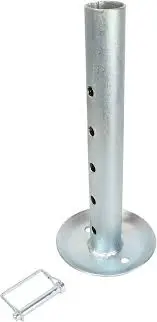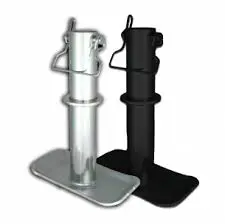Can I Use a Trailer Jack Stand Foot for Heavy-Duty Trailers?
2025-02-20 09:33:11
When it comes to heavy-duty trailers, ensuring stability and safety during loading, unloading, and maintenance is paramount. One crucial component that plays a significant role in this aspect is the trailer jack stand foot. This blog explores the use of trailer jack stand feet for heavy-duty trailers, delving into their importance, benefits, and considerations. We'll examine how these specialized components contribute to the overall safety and functionality of your trailer, helping you make informed decisions about their application in your heavy-duty trailer setup.

Understanding Trailer Jack Stand Feet and Their Role in Heavy-Duty Applications
What are Trailer Jack Stand Feet?
Trailer jack stand feet are essential components designed to provide stability and support for trailers when they're not attached to a towing vehicle. These feet, typically made of durable materials like galvanized steel or high-strength polymers, attach to the bottom of trailer jacks or stabilizing legs. Their primary purpose is to distribute the weight of the trailer across a wider surface area, preventing the jack from sinking into soft ground or damaging hard surfaces.
The Importance of Proper Support for Heavy-Duty Trailers
Heavy-duty trailers, by nature, carry substantial loads and require robust support systems. The use of appropriate trailer jack stand feet is crucial for several reasons:
- Weight Distribution: They help evenly distribute the trailer's weight, reducing stress on the frame and suspension.
- Stability: Proper feet enhance the overall stability of the trailer, especially on uneven terrain.
- Safety: They provide a secure foundation, minimizing the risk of trailer tipping or shifting during loading or maintenance.
- Surface Protection: Quality feet protect the ground surface from damage, particularly important on concrete or asphalt.
Types of Trailer Jack Stand Feet Suitable for Heavy-Duty Use
Several types of trailer jack stand feet are available, each suited for different heavy-duty applications:
- Flat Plate Feet: Ideal for solid, level surfaces, offering wide weight distribution.
- Swivel Feet: These adjust to uneven ground, ensuring maximum contact and stability.
- Sand Feet: Designed with a larger surface area to prevent sinking in soft soil or sand.
- Heavy-Duty Ribbed Feet: Feature reinforced designs for extreme weight capacities.
Factors to Consider When Choosing Trailer Jack Stand Feet for Heavy-Duty Trailers
Weight Capacity and Load Requirements
The most critical factor in selecting trailer jack stand feet for heavy-duty applications is ensuring they can support the weight of your trailer and its maximum load. Consider these points:
- Gross Trailer Weight (GTW): Calculate the total weight of your trailer when fully loaded.
- Safety Margin: Choose feet with a weight capacity that exceeds your GTW by at least 20%.
- Weight Distribution: Consider how the weight is distributed across multiple jack stands or stabilizers.
- Dynamic Loads: Factor in additional stress from loading and unloading operations.
It's crucial to select trailer jack stand feet that can comfortably handle the maximum anticipated load to ensure safe and stable operation.
Material and Durability Considerations
The material of your trailer jack stand feet plays a significant role in their performance and longevity:
- Galvanized Steel: Offers excellent strength and corrosion resistance, ideal for outdoor use.
- Stainless Steel: Provides superior rust resistance, suitable for marine environments.
- High-Density Polyethylene (HDPE): Lightweight, durable, and resistant to cracking or chipping.
- Reinforced Composites: Combine strength with lightweight properties for easy handling.
Consider the environment in which you'll be using your trailer and choose materials that offer the best combination of strength, durability, and corrosion resistance.
Compatibility with Existing Trailer Jack Systems
Ensuring compatibility between your chosen trailer jack stand feet and your existing trailer jack system is essential:
- Mounting Method: Check if the feet use a bolt-on, slip-on, or other attachment method compatible with your jacks.
- Size and Dimensions: Verify that the foot size matches the base of your jack or stabilizer leg.
- Load Rating Alignment: Ensure the feet's load rating matches or exceeds that of your jack system.
- Adjustability: Consider whether you need fixed or adjustable feet based on your typical usage scenarios.
Proper compatibility ensures optimal performance and prevents potential safety issues or damage to your trailer or jack system.
Best Practices for Using Trailer Jack Stand Feet on Heavy-Duty Trailers
Proper Installation and Maintenance
Correct installation and regular maintenance of trailer jack stand feet are crucial for their effective operation:
- Follow Manufacturer Instructions: Always adhere to the manufacturer's guidelines for installation and use.
- Secure Attachment: Ensure all bolts or fasteners are tightened to the specified torque.
- Regular Inspections: Check for signs of wear, damage, or corrosion before each use.
- Cleaning: Keep feet clean from dirt and debris to maintain their functionality.
- Lubrication: Apply appropriate lubricants to moving parts as recommended by the manufacturer.
Proper care and maintenance extend the life of your trailer jack stand feet and ensure they remain safe and effective.
Safety Precautions and Usage Tips
Implementing safety measures when using trailer jack stand feet on heavy-duty trailers is essential:
- Level Ground: Always park on level, stable ground when using jack stands.
- Multiple Support Points: Use multiple jack stands for added stability, especially for longer trailers.
- Weight Distribution: Ensure the trailer's weight is evenly distributed across all support points.
- Chock Wheels: Always use wheel chocks to prevent trailer movement during setup.
- Visual Checks: Perform a visual inspection of the setup before loading or working on the trailer.
- Avoid Overloading: Never exceed the rated capacity of your trailer jack stand feet or jack system.
Adhering to these safety practices helps prevent accidents and ensures the stability of your heavy-duty trailer.
Adapting to Different Terrains and Environments
Heavy-duty trailers often encounter various terrains and environmental conditions. Adapting your use of trailer jack stand feet accordingly is crucial:
- Soft Ground: Use wide-base feet or additional support plates to prevent sinking.
- Uneven Surfaces: Opt for adjustable or swivel feet to ensure proper contact and weight distribution.
- Extreme Temperatures: Choose materials that can withstand your climate, such as UV-resistant plastics for hot environments.
- Corrosive Environments: In coastal or industrial areas, use corrosion-resistant materials like stainless steel.
- Varied Use Cases: Consider having multiple types of feet available for different scenarios.
By adapting your trailer jack stand feet to specific conditions, you ensure optimal performance and safety across various environments.

Conclusion
Trailer jack stand feet are indispensable for ensuring the stability and safety of heavy-duty trailers. By choosing the right type, considering crucial factors, and following best practices, you can significantly enhance the functionality and safety of your trailer operations. Remember, proper selection and use of these components are key to maintaining a secure and efficient heavy-duty trailer setup. If you want to get more information about this product, you can contact us at info@qdkshd.com.
References
1. "Heavy-Duty Trailer Stabilization: A Comprehensive Guide to Jack Stand Feet"
2. "Maximizing Safety in Heavy-Duty Trailer Operations: The Role of Proper Support Systems"
3. "Materials Science in Trailer Components: Advancements in Jack Stand Foot Design"
4. "Comparative Analysis of Trailer Jack Stand Feet for Various Load Capacities"
5. "Environmental Adaptability of Trailer Support Systems: A Study on Jack Stand Feet"
6. "Best Practices for Maintaining and Utilizing Trailer Jack Stand Feet in Industrial Applications"
Send Inquiry
You may like
